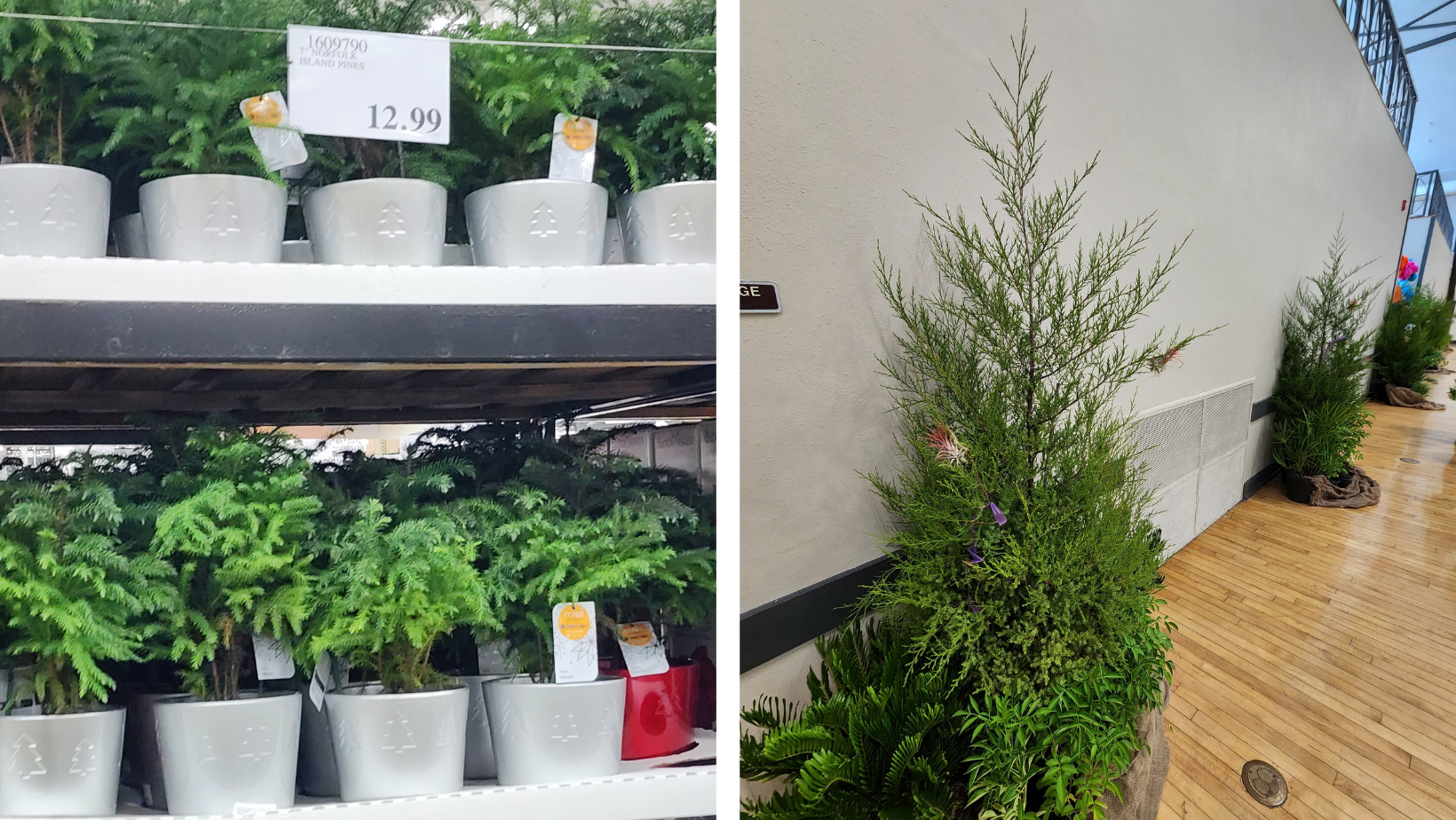
Why you should choose Native Red Cedar Over Norfolk Island Pines for a Florida-Friendly Holiday Season
As the holiday season approaches, many households eagerly purchase festive plants. One commonly purchased plant for the season is the ‘Norfolk Island Pine’. A popular choice due to its widespread availability. Surprisingly, the majority of trees sold as Norfolk Island Pines are, in fact, Cook Island Pines, both belonging to the Araucaria genus. These two species share a similar appearance when young, which leads to incorrect labeling. In this blog post we will just call these common nonnative pines collectively as Araucaria pines. We’ll explore the drawbacks of Araucaria Pines and compare them to the native Red Cedars (Juniperus virginiana), a far superior tree to plant in your landscape after the holidays are over. Also at the time of this blog post, Red Cedars from our local members of the Florida Association of Native Nurseries, were roughly half the cost ($7.50 versus $12.99) of ‘Norfolk Island Pines’ at our big box stores for a similar sized plant! So we hope you support local small businesses, decorate with natives, and have Florida-Friendly Landscaping™ in mind this holiday season after reading this blog!

The Downside of Araucaria Pines
Size Concerns
One major drawback of Araucaria Pines is their considerable size. These trees quickly grow to towering heights, posing challenges for small properties. At mature size being over 80ft tall by 20 ft wide. Additionally, their height makes them potential lightning rods during storms, posing safety risks to both property and residents. Also, if you decide to remove a Araucaria Pine in the future, be prepared for high expenses. The size and complexity of these trees make removal a costly endeavor, involving specialized equipment and expertise. In contrast, the smaller Eastern Red Cedars are generally more manageable, easing the burden on your wallet.
Charlie Brown’s Christmas Tree
The Araucaria Pines are sometimes regarded as the “Charlie Brown” Christmas tree. Its sparse branches are reminiscent of the iconic scrawny tree from the Peanuts comic strip. The Eastern Red Cedar is a more visually appealing option due to its dense growth habit.
Lack of Wildlife Benefits
Araucaria Pines are non-native trees and they do not provide the same ecological benefits as native species. From what I have seen Cook Island Pines only provide shelter for a few select species, mostly birds of prey. Native Slash and Longleaf Pines are also superior for this wildlife niche.

Eastern Red Cedar Advantages
Aesthetics: Shape, Size, Fullness, and Color
Eastern Red Cedars boast full, pyramidal shape that lends itself well to holiday decorations. Some cultivars can be deep green while others have been cultivated for their silver foliage as a trait. The Eastern Red Cedar’s denser growth also provides a more visually appealing backdrop for your festive decorations. Unlike the towering Araucaria Pine, Eastern Red Cedars also offer a more manageable size for both indoor and outdoor use. Usually being 40 ft tall by 20ft wide at mature size in Florida. If space is a concern, consider the ‘Skyrocket‘ or ‘Brodie’ cultivar, known for its compact columnar shape. These cultivars maintain the classic beauty of the native Red Cedar while fitting comfortably into smaller horizontal spaces. Expect 8-10 ft in width with these columnar cultivars of Red Cedar.
Ecological Benefits
Choosing a native tree like the Eastern Red Cedar brings ecological advantages. The tree’s foliage and numerous small berries attract wildlife, with the Cedar Waxwing being a notable migratory bird visitor. The dense, evergreen foliage also is a favorite of many diverse species of birds for making nests in. Supporting local wildlife in your landscape is a key principle of Florida-Friendly Landscaping™, and contributes to the overall health and biodiversity of your local ecosystem.
Conclusion
When selecting a tree for holiday decoration that you plan to incorporate into your landscape afterward, Eastern Red Cedars stand out as the superior choice. From their aesthetic appeal to the ecological benefits they bring, these native trees offer a more sustainable and environmentally friendly option compared to Araucaria Pines. Make this holiday season not only beautiful but also better for our environment by choosing the timeless elegance of the native Eastern Red Cedar.
Resources:
- UF/IFAS Gardening Solutions: Red Cedar https://gardeningsolutions.ifas.ufl.edu/plants/trees-and-shrubs/trees/red-cedar.html
- UF/IFAS Red Cedar EDIS Document: https://edis.ifas.ufl.edu/publication/ST331
- UF/IFAS ‘Skyrocket’ Red Cedar EDIS Document: https://edis.ifas.ufl.edu/publication/ST334
- Florida Association of Native Nurseries to find Red Cedars for Sale: https://www.fann.org/professionals
- Florida Native Plant Society page on Red Cedar: https://www.fnps.org/plant/juniperus-virginiana
During the preparation of this work, the author used ChatGPT to help build the blog post. After using this tool/service, the author reviewed and edited the content, and takes full responsibility for the content of the publication.
 7
7
